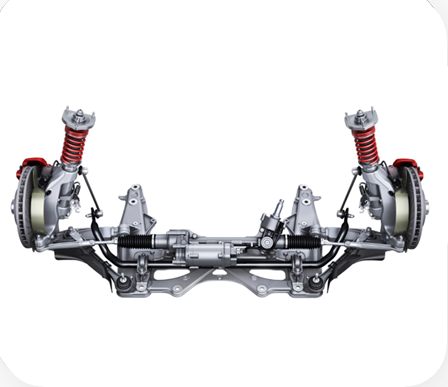
What is MacPherson strut suspension: MacPherson is a simple independent suspension design widely used in the front suspension of modern vehicles. It’s based around a basic triangular design in two parts.
it is named after American automotive engineer Earle S. MacPherson, who invented and developed the design.

Earle S. MacPherson was appointed the chief engineer of Chevrolet's Light Car project in 1945, to develop new smaller cars for the immediate post-war market. That gave rise to the Chevrolet Cadet. These incorporated the first MacPherson strut independent suspension both in front and rear. The Cadet project was cancelled in 1947 and the disgruntled MacPherson was enticed to join Ford. Patents were filed in 1947 (U.S. Patent 2,624,592 for GM) and in 1949 (U.S. Patent 2,660,449 for Ford), the 1949 patent citing designs by Guido Fornaca of FIAT in the mid-1920s.
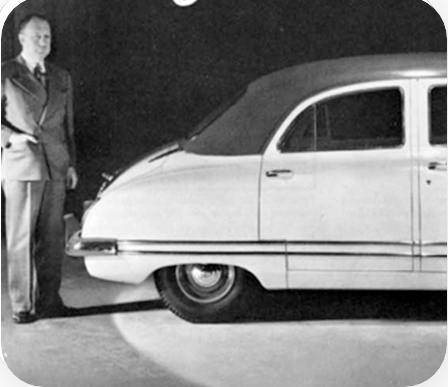
MacPherson designed the strut for all four wheels, but it is normally used for the front suspension only, where it provides a steering pivot as well as a suspension mounting for the wheel.
The first production car to use MacPherson struts is often cited incorrectly as the French 1949 Ford Vedette, but it was developed before MacPherson, with an independent front suspension based on wishbones and an upper coil spring. Only in 1954, after the Vedette factory had been purchased by Simca, did the revised Simca Vedette switch to using front struts.
Following MacPherson's arrival at Ford, the first production car to feature MacPherson struts was the British-built 1950 Ford Consul and the later Zephyr.
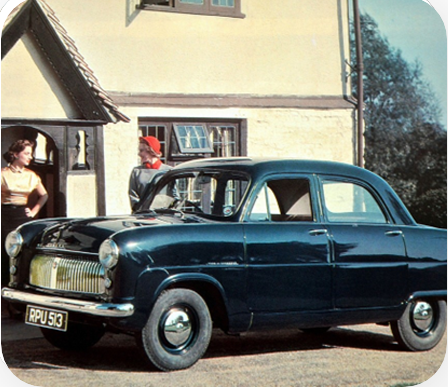
A MacPherson strut uses a wishbone, or a substantial compression link stabilized by a secondary link, which provides a mounting point for the hub carrier or axle of the wheel. The lower arm system provides both lateral and longitudinal location of the wheel. The upper part of the hub carrier is rigidly fixed to the bottom of the outer part of the strut proper. That slides up and down the inner part of it, which extends upwards directly to a mounting in the body shell of the vehicle. The line from the top mount of the strut to the bottom ball joint on the control arm gives the steering axis inclination. The axis of the strut may be angled inwards from the steering axis at the bottom, to clear the tyre, which makes the bottom follow an arc when steering.
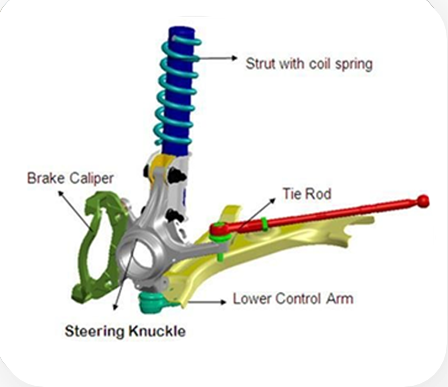
The MacPherson strut benefited from introduction of unitary construction, because its design requires substantial vertical space and a strong top mount, which unibody construction can provide. Unibody construction also distributes suspension stresses. The strut will usually carry both the coil spring, on which the body is suspended, and the shock absorber, which is usually in the form of a cartridge mounted within the strut. The strut can also have the steering arm built into the lower outer portion. The whole assembly is very simple and can be pre-assembled into a unit. As well, the elimination of the upper control arm allows for more width in the engine compartment, which is useful for smaller cars, particularly with transverse-mounted engines, such as most front wheel drive vehicles have. The assembly can be further simplified, if needed, by substituting an anti-roll bar for the radius arm. For those reasons, it has become almost ubiquitous with low cost manufacturers. Furthermore, it offers an easy method to set suspension geometry.
Many modern versions replace the lower control arm with a wishbone. An anti-roll bar is optional and, if present, is attached by a ball-jointed rod to the spring-damper, or by a ball or elastomerically jointed rod to the wishbone.
Because MacPherson struts are packaged with a significant structure in the front crash structure of the car, it is easier to engineer cars that pass more stringent small overlap crashes with struts, as opposed to those with a double wishbone suspension. Notable examples include the Honda Accord and Civic, as well as the Mercedes E-Class, all of which adopted struts to improve crash performance. The overall simplicity of the design also means there are fewer joints in the suspension to wear, so there is less decline in handling and steering feel over time. Inverted monotube struts can also provide extra rigidity in the front suspension, as seen in the Porsche 911 GT3 and Cayman GT4, as well as the Subaru Impreza WRX STI.
Finally, struts can package more efficiently than other types of front suspension, which allows for significant front cargo space in rear/mid-engined cars, such as the Porsche 911 and Boxster.
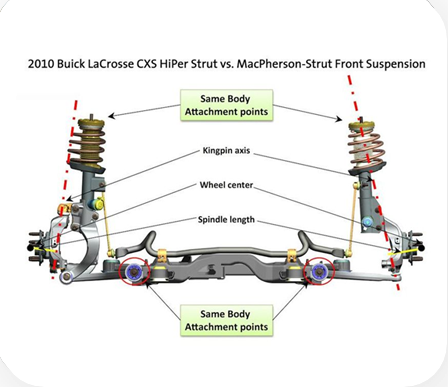
Geometric analysis shows the assembly cannot allow vertical movement of the wheel without some degree of either camber angle change, sideways movement, or both. It is not generally considered to give as good handling as a double wishbone or multi-link suspension, because it allows the engineers less freedom to choose camber change and roll center. Cars that have cockpit adjustable ride height generally cannot have MacPherson struts because of the camber changes that are an unavoidable part of the design. Ride suffers because the shock absorber has almost the same vertical motion as the wheel, so there is relatively little leverage to break the stiction in the seals. A standard single pivot MacPherson strut also tends to have positive scrub where the center of the steering axis is offset from the center of the front tires, which results in torque steer.
Despite the drawbacks, the MacPherson strut set-up is still used on some high performance cars, because they tend to have relatively small suspension travel, and so do not have the same kinematic problems.
Up until the 1989 model year (964), Porsche 911 used a similar strut design that did not have coil springs, using torsion bar suspension instead. Since then, all Porsche 911s have had front MacPherson struts, except the 992-based 911 GT3, which uses a double wishbone.
In recent years, General Motors and Ford have introduced a modified strut set-up, "Hi-Per Strut" and "Revoknuckle" respectively, that split the strut into two components that handle the up-and-down flexibility and steering dynamics separately. The benefits of this design are greater surface contact and reduction in torque steer. The drawbacks are the additional weight and cost, but it is less expensive than either a double wishbone or multi-link setup. Honda introduced another variation strut set-up, called "dual-axis", which is used in the suspension design of the Civic Type-R.
sources:
https://en.wikipedia.org/wiki/MacPherson_strut
https://www.carthrottle.com/post/what-is-macpherson-strut-suspension-and-why-is-it-so-popular/
https://autoquarterly.com/what-is-a-macpherson-strut/
https://autoquarterly.com/what-is-a-macpherson-strut/
https://www.caricos.com/cars/p/porsche/2016_porsche_cayman_gt4/images/14.html
https://www.autoevolution.com/cars/ford-consul-1950.html#aeng_ford-consul-1950-17
https://www.researchgate.net/figure/A-representation-of-Macpherson-Suspension-System_fig1_329884872
edited by ascari
